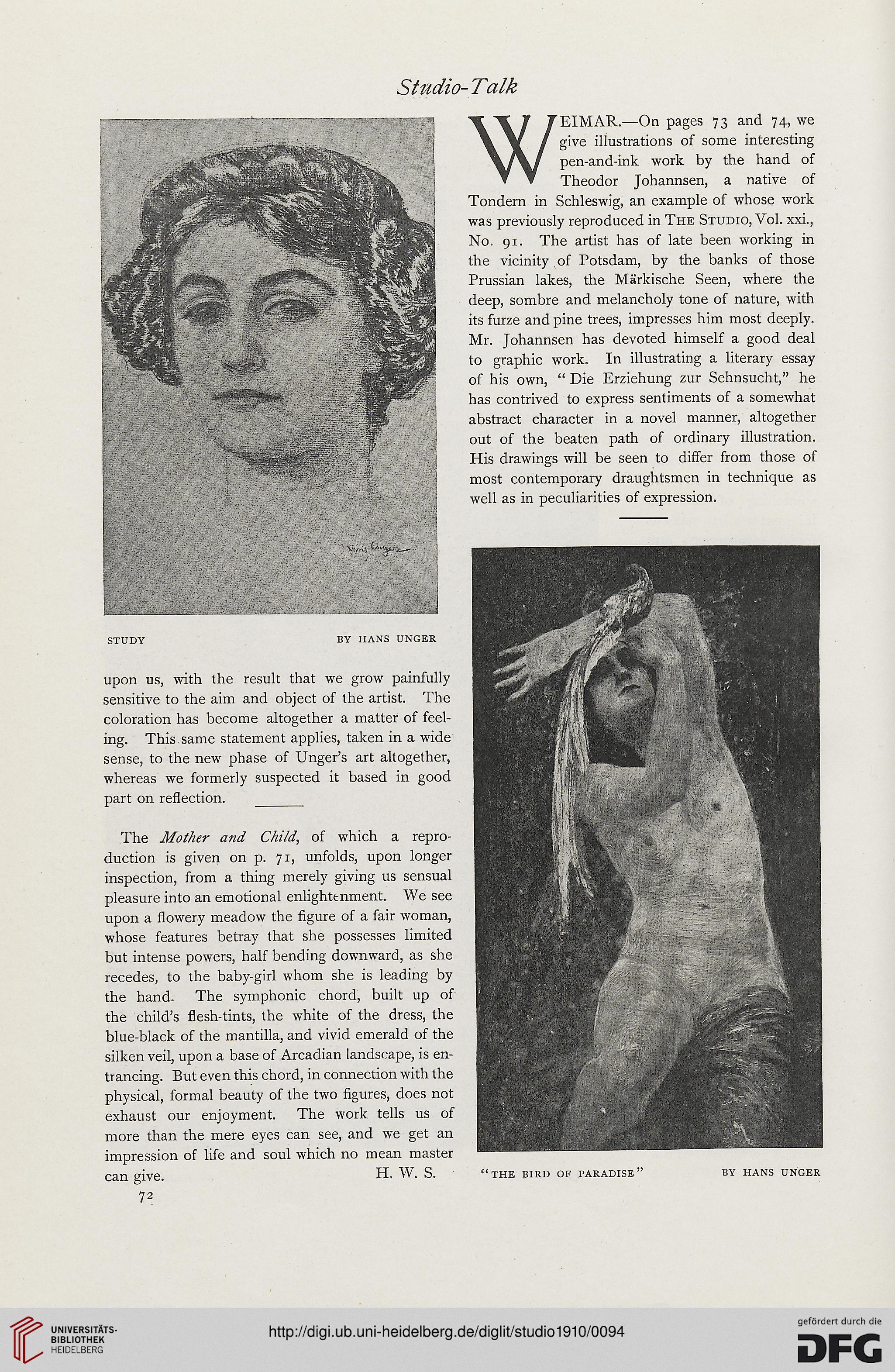Stndio-Talk
STUDY BY HANS UNGER
upon us, with the result that we grow painfully
sensitive to the aim and object of the artist. The
coloration has become altogether a matter of feel-
ing. This same statement applies, taken in a wide
sense, to the new phase of Unger's art altogether,
whereas we formerly suspected it based in good
part on reflection. _
The Mother and Child, of which a repro-
duction is given on p. 71, unfolds, upon longer
inspection, from a thing merely giving us sensual
pleasure into an emotional enlightenment. We see
upon a flowery meadow the figure of a fair woman,
whose features betray that she possesses limited
but intense powers, half bending downward, as she
recedes, to the baby-girl whom she is leading by
the hand- The symphonic chord, built up of
the child's flesh-tints, the white of the dress, the
blue-black of the mantilla, and vivid emerald of the
silken veil, upon a base of Arcadian landscape, is en-
trancing. But even this chord, in connection with the
physical, formal beauty of the two figures, does not
exhaust our enjoyment. The work tells us of
more than the mere eyes can see, and we get an
impression of life and soul which no mean master
can give. H. W. S.
72
WEIMAR.—On pages 73 and 74, we
give illustrations of some interesting
pen-and-ink work by the hand of
Theodor Johannsen, a native of
Tondern in Schleswig, an example of whose work
was previously reproduced in The Studio, Vol. xxi.,
No. 91. The artist has of late been working in
the vicinity of Potsdam, by the banks of those
Prussian lakes, the Markische Seen, where the
deep, sombre and melancholy tone of nature, with
its furze and pine trees, impresses him most deeply.
Mr. Johannsen has devoted himself a good deal
to graphic work. In illustrating a literary essay
of his own, " Die Erziehung zur Sehnsucht," he
has contrived to express sentiments of a somewhat
abstract character in a novel manner, altogether
out of the beaten path of ordinary illustration.
His drawings will be seen to differ from those of
most contemporary draughtsmen in technique as
well as in peculiarities of expression.
"THE BIRD OF PARADISE" BY HANS UNGER
STUDY BY HANS UNGER
upon us, with the result that we grow painfully
sensitive to the aim and object of the artist. The
coloration has become altogether a matter of feel-
ing. This same statement applies, taken in a wide
sense, to the new phase of Unger's art altogether,
whereas we formerly suspected it based in good
part on reflection. _
The Mother and Child, of which a repro-
duction is given on p. 71, unfolds, upon longer
inspection, from a thing merely giving us sensual
pleasure into an emotional enlightenment. We see
upon a flowery meadow the figure of a fair woman,
whose features betray that she possesses limited
but intense powers, half bending downward, as she
recedes, to the baby-girl whom she is leading by
the hand- The symphonic chord, built up of
the child's flesh-tints, the white of the dress, the
blue-black of the mantilla, and vivid emerald of the
silken veil, upon a base of Arcadian landscape, is en-
trancing. But even this chord, in connection with the
physical, formal beauty of the two figures, does not
exhaust our enjoyment. The work tells us of
more than the mere eyes can see, and we get an
impression of life and soul which no mean master
can give. H. W. S.
72
WEIMAR.—On pages 73 and 74, we
give illustrations of some interesting
pen-and-ink work by the hand of
Theodor Johannsen, a native of
Tondern in Schleswig, an example of whose work
was previously reproduced in The Studio, Vol. xxi.,
No. 91. The artist has of late been working in
the vicinity of Potsdam, by the banks of those
Prussian lakes, the Markische Seen, where the
deep, sombre and melancholy tone of nature, with
its furze and pine trees, impresses him most deeply.
Mr. Johannsen has devoted himself a good deal
to graphic work. In illustrating a literary essay
of his own, " Die Erziehung zur Sehnsucht," he
has contrived to express sentiments of a somewhat
abstract character in a novel manner, altogether
out of the beaten path of ordinary illustration.
His drawings will be seen to differ from those of
most contemporary draughtsmen in technique as
well as in peculiarities of expression.
"THE BIRD OF PARADISE" BY HANS UNGER




